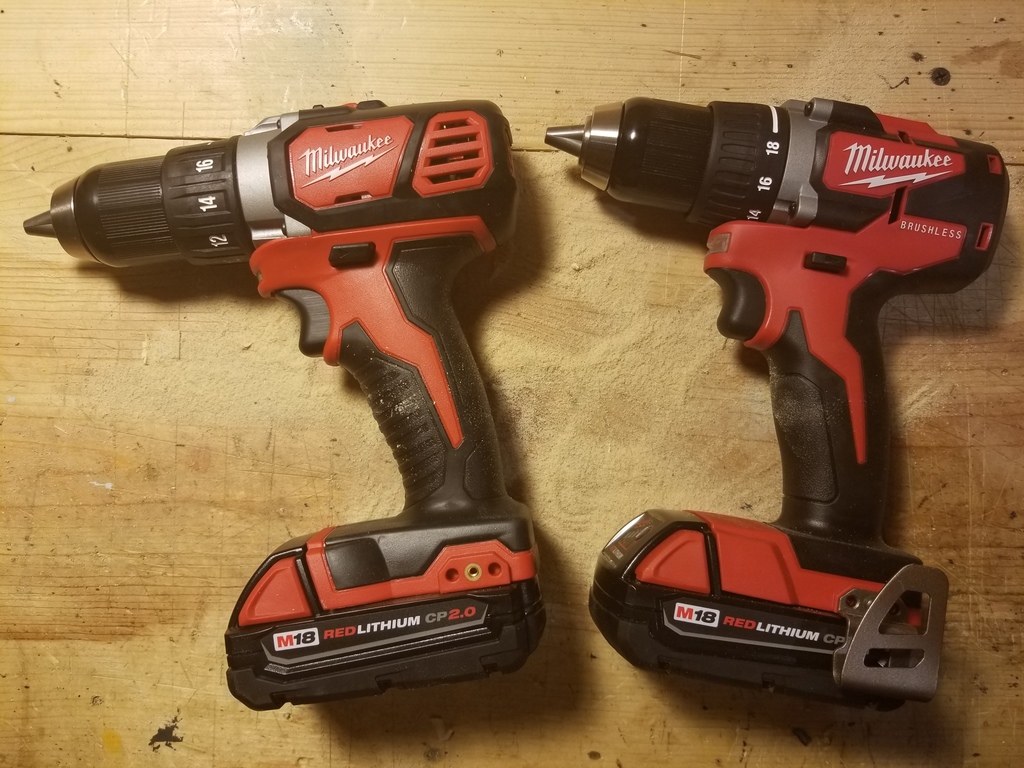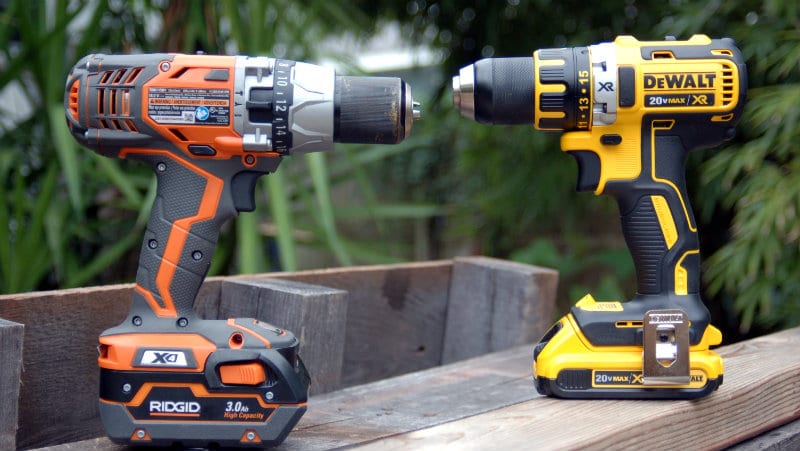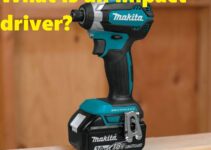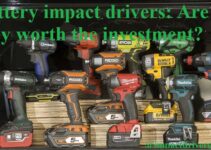You may be asking yourself the question, “What’s the difference between brushless and brushed impact drivers?”
Here’s your comprehensive guide with all the information you need to make an informed decision about what type of impact driver is right for you. Not only will you be able to understand how each type of impact driver works but also which one offers the best value and performance.
Impact drivers are among the most convenient tools available for driving fasteners, such as screws and bolts. They are highly popular among both professionals and DIY handymen due its versatility and range of applications. It can dramatically reduce the time taken for tightening or loosening screws as compared to conventional screwdrivers. With increasing DIY projects, there is a rising demand for impact drivers that come in two types – brushed and brushless.
It is important to know the difference between these two types before you decide on which one to buy. This article will explain their differences in terms of design, performance and applications.
Explanation of impact drivers
Impact drivers are an essential tool to have in any power user’s arsenal. They come in both brushless and brushed varieties, and understanding the difference between these two types is key to making the right purchase decision.
Impact drivers use a rotating hammering action to quickly put screws and fasteners into tough materials without stripping them or damaging the surface. This power comes from an electric motor that focuses a greater amount of torque than a standard drill, allowing for faster job completion times.
The difference between brushless and brushed impact drivers lies primarily in the type of electric motor utilized by each one. Brushless motors have no external brushes, relying instead on electronic commutation to generate torque efficiently. Conversely, brushed motors employ brushes that make contact on the commutator rings within the motor housing; as these brushes wear out, however, it can reduce power output over time. Choosing which type is best for your usage will depend on your preference for quick repairs versus speed of job completion.
Importance of knowing the difference between brushed and brushless impact drivers
It is important to understand the difference between brushed and brushless impact drivers before making a purchase, as these differences impact the power, durability and cost of the impact driver.
Brushed motors are often cheaper than brushless models and can offer adequate speed or torque for most applications. However, they take more time to cool down after use and have fewer rpm options than brushless models.
Brushless motors on the other hand have higher-quality construction which equates to an extended life with high levels of power output while at lower temperatures than their brushed counterparts. Brushless models are often more expensive but provide a significant upgrade in performance at a competitive price.
Additionally, A brushless motor is electronically commutated motor designed to be more efficient and longer lasting than traditional brushed motors by eliminating physical contact between moving parts.
Brushed impact drivers
Brushed impact drivers are the traditional style of impact drivers. They feature an electric motor with a comb-like configuration of copper wires and magnets. This construction gives them their “brushed” designation. This type of motor is more affordable to produce than its brushless counterpart, thus making it the preferred choice for lighter use in DIYers and budget-conscious consumers.
In terms of operation, brushed motors are powered by carbon brushes which cause sparks to generate when they make contact with a spinning armature inside the motor. This spark helps keep the speed steady and consistent, even under heavy loads. In addition, brushed motors tend to be bulkier and have a shorter lifespan because their parts wear out faster due to friction between the brushes and armature caused by the spark.
When considering a brushed motor for your impact driver needs, consider the following points:
- Weight- Brushed motors tend to be heavier than their brushless counterparts due to their bulkier design. This makes them difficult to maneuver in tight spaces or quickly switch from one drilling location to another without strain on your arms or wrists.
- Speed Variation- Carbon brushes help maintain consistent speed during operation but can cause fluctuations depending on how hard you press down with the drill bit or how much force you apply when attaching accessories like screw heads or nuts/boltsheads. These variations can cause inconsistencies in job results as well as added time for certain projects that require multiple reruns due to inaccurate functioning from variances in speed up/down performance from your impact driver caused by its brushed motor construction. Therefore you need to assess your individual task needs before deciding between brushless vs brushe.
Definition of brushed impact drivers
A brushed impact driver is a rare, but reliable tool used in industrial and commercial applications. It is designed to deliver powerful torque with minimal effort, making it the ideal choice for any kind of job that requires substantial force to be exerted in a very short amount of time.
A brushless impact driver uses magnets to spin the drive motor and deliver fast, efficient power without the need for brushes, which are required for a standard brushed motor.
Brushed impact drivers operate on electrical impulses generated by electricity passing through metal brushes which transfer to an armature connected with the bit that drives the screw or nut being tightened. This produces extreme torque that can reach up to 200 ft.-lbs. However, brushing also produces friction and heat build-up over time which reduces their efficiency and lifespan significantly.
On the other hand, brushless impact drivers use an electric current via coils surrounding a permanent magnet to generate motion and power transfer from its two parts- stator and rotor allowing it attain higher speeds compared with brushed motors without brushes’ inherent mechanical energy loss due to friction between them. While being more expensive than ordinary brushed models due to its sophisticated construction they combine superior power output as well as extended durability making it arguably one of the finest tools of its kind in terms of performance and value for money ratio available on market today.
How they work
Brushless impact drivers, as the name implies, don’t have brushes in their motor. Instead, they make use of a specifically designed electronic speed control (ESC) system to regulate the speed and power of the driver. This motor is typically powered by an external power source such as a set of rechargeable batteries.
Unlike brushed motors, brushless motors are much quieter and more efficient since they don’t need to spin up the brushes in order to transfer energy from the battery to the armature. They are also exceptionally durable due to their lack of friction-prone parts. The ESC system also helps reduce heat dissipated by the motor while allowing for higher speed than would be possible with a brushed motor with no ESC. However, brushless motors can be more expensive than their brushed counterparts since they require dedicated parts for controlling their speeds and power levels.
Comparison between brushed and brushless impact drivers
Brushed and brushless impact drivers both provide powerful torque for a wide range of tasks, but there are important differences between them. Comparing the two types of impact drivers can help you decide which is the best choice for your work.
Brushless impact drivers typically offer more efficient operation than brushed impact drivers, as they have no motor brushes to generate friction and heat. This means that brushless motors generally use less energy and operate more quietly than brushed motors. However, brushless motors are typically more expensive than their counterparts with brushes.
The other main difference between brushless and brushed impact drivers is in their torque output. Brushless models have higher top speeds and greater maximum torque output than brushed variants, making them well-suited for the most demanding jobs such as drilling into concrete or boring large diameter holes in metals or wood studs.
Finally, when it comes to durability, brushless models generally last longer than brushed riders due to their lack of moving parts that can wear down over time. The lower heat generation from these motors also means they don’t require regular maintenance like brushed models do and are generally less prone to breakdowns compared to the latter type of impact driver.
Differences in performance
Brushless impact drivers and their brushed counterparts differ significantly in terms of performance. Brushless impact drivers have longer runtimes and offer greater speed, torque, and power than brushed models. This means that brushless impact drivers are able to rapidly deliver more rotational force to drive in larger screws. Despite the differences in performance, brushless and brushed motors will typically be similar in size.
The brushless motor design has lower maintenance requirements since there are no moving parts involved-it’s also more efficient, as less energy is dissipated as heat when compared to a brushed model. The main benefit of a brushless motor is its longer lifespan, as they won’t wear down quickly like their brushed counterparts. The downside is that they can be significantly more expensive depending on the brand and quality of the motor. However, the longevity of these motors make them a worthy investment for those who use their tools regularly or professionally on job sites.
Differences in maintenance
Brushless impact drivers require less maintenance than traditional brushed models, as there are no carbon brushes that need to be changed. The lack of brushes also means each time you start the impact driver, it is at its full power. This makes brushless models a good option for those who plan on using their drill frequently.
Additionally, due to the improved motor design, brushless impact drivers tend to produce longer battery life and will last longer thus requiring less maintenance repairs over time. Additionally, some manufacturers offer “smart” features in their brushless motors that allow them to optimize performance based on the load being placed on the tool.
It should be noted however, that although these tools may require less maintenance than traditional brushed ones, they can still become damaged if enough wear and tear is applied over time – such as if it’s dropped or exposed to too much dust or water. Therefore, appropriate safety precautions should still be taken when using both types of drills in order to protect them from potential damage.
Factors to consider when choosing between brushed and brushless impact drivers
When selecting between a brushed or brushless impact driver, there are a few factors worth considering. These include size and weight, power delivery, performance, battery life, and cost.
Size and weight: Brushed motors tend to be lightweight and compact in size due to their simple design. Brushless motors are typically heavier and larger which can affect the usability of them.
Power delivery: Brushless motors generate smoother power which is beneficial when it comes to precision maintenance or delicate assembly jobs; whereas brushed motors can produce more torque with their powerful surges of electricity.
Performance: Brushless motors generally provide greater performance as they deliver more efficient energy use providing increased durability as well as extended runtimes when compared with brushed motors.
Battery life: Brushless motors tend to be more energy-efficient than brushed ones resulting in longer battery life due to the way that they deliver a consistent and continuous flow of power over time while also keeping temperatures cool by avoiding build-up of heat; whereas typical Brushed drivers have shorter runtimes as they tend to overheat quickly as they overwork before needing recharging or replacing completely.
Cost: Brushed drivers are cheaper than brushless due to their simpler design; however, brushless drivers might represent the better value for money in the long-term if you need higher performance, longer runtime capabilities and improved durability.
Budget
When it comes to choosing the right impact driver for your needs, budget is key. Impact drivers come in a variety of styles, brands, and price ranges. This section helps you decide whether to go with a more expensive brushless option or a more affordable brushed solution.
Brushed impact drivers are typically the least expensive option and can be found in lower powered models and designs. They generally come with less torque, fewer speed settings, less automation features, and fewer accessories and attachments than brushless options.
Brushless impact drivers are much more expensive but offer superior power, speed control and automation features compared to brushed models. In general these tools will last longer than their brushed counterparts due to having fewer parts that wear out over time. Additionally brushless impact drivers usually include extra bells-and-whistles such as LED lights or automatic kickstands that can help make your job faster and easier.
Intended use
Brushless impact drivers are designed for heavier applications and more frequent use. They provide greater precision over brushed models and handle heavier workloads more efficiently by eliminating the wear and tear associated with a motor’s brushes. As a result they’re well-suited for jobs that require higher impacts, such as working with hardwood, driving screws through metal, or repetitive work such as assembly line tasks. This makes brushless impact drivers ideal for professional application in automotive shops or factories.
On the other hand, brushed impact drivers are typically used in lighter-duty applications with higher run time expectations. They’re well-suited for at-home projects such as furniture projects, construction of decks and fences, remodeling of interior living spaces and other similar activities. Brushed impact drivers provide sufficient power efficiency at an economical cost and are an excellent choice for most DIY projects on the weekend warrior list.
Personal preferences
When it comes to impact drivers, it really comes down to personal preference. Some people favor the convenience of the brushless option, while others love the simplicity of a brushed version. Ultimately, your choice will depend on how you want to use it and what you need from it.
If you’re looking for more power and torque, a brushless impact driver might be the way to go. It is capable of handling heavier tasks more quickly and offers more control over the speed of your project. But if you’re looking for something simpler and don’t need as much power, a brushed option may be best.
In addition to these individual features, your budget should be taken into account when choosing an impact driver. Brushless models tend to cost more than brushed versions and both can vary widely in quality and lifespan depending on their construction materials and individual components. In this case, do some research on different brands so that you can make an informed decision before making a purchase.
Conclusion
Ultimately, the choice between brushless vs. brushed impact drivers comes down to each individual’s preferences and needs. Both technologies have their pros and cons, but ultimately it is up to you to decide which the best option is for your projects.
Brushless impact drivers tend to be more durable, lightweight and powerful than brushed motors, making them ideal for high-load applications. On the other hand, brushed motors are more affordable and are suitable for lighter projects with less torque requirements. If you want something that is powerful yet affordable, a good quality brushed model might be the way to go. However, if you are looking for something really powerful and long lasting, then brushless units are definitely worth considering.
No matter which type of motor you choose for your projects –brushless or brushed – having an impact driver in your toolbox can make many jobs easier and faster. Weighing up the options will enable you to make the best decision for your needs when it comes down to picking between brushes vs brushes impact drivers.
FAQs
Are brushed or brushless impact drivers better?
Brushless impact drivers are generally considered better due to their higher efficiency, longer lifespan, and greater power output.
What is the difference between brushed and brushless driver?
Brushed drivers use carbon brushes to transfer electrical current to the motor, while brushless drivers use electronic circuitry to control the motor’s operation.
What is the benefit of brushed motors over brushless?
Brushed motors are generally less expensive and simpler to manufacture than brushless motors.
Which is better brushless motor brush and motor?
Brushless motors are generally considered better due to their higher efficiency, longer lifespan, and greater power output.
What is the disadvantage of brushless?
Brushless motors are generally more expensive and more complex to manufacture than brushed motors.
Which type of impact driver is best?
The best type of impact driver depends on the specific needs of the user, but brushless impact drivers are generally considered to be the best overall.
Do brushless motors last longer than brushed?
Yes, brushless motors typically last longer than brushed motors due to their more efficient and durable design.
What are the disadvantages of brushed DC motor?
Brushed DC motors are generally less efficient, less durable, and more prone to wear and tear than brushless motors.
Are brushed motors cheaper than brushless?
Yes, brushed motors are generally less expensive than brushless motors.
Why are brushless tools more expensive?
Brushless tools are more expensive due to their more complex and advanced design, which requires more expensive materials and manufacturing processes.
See Also-
- Best impact driver
- Best impact driver for lug nuts
- Best makita impact driver
- Best milwaukee impact driver
- Best ryobi impact driver


